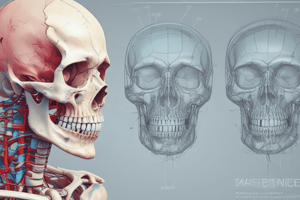Podcast
Questions and Answers
What is the key characteristic of an iterative reconstruction process?
What is the key characteristic of an iterative reconstruction process?
- It uses a predefined lookup table to map the measured data to the final reconstruction.
- It directly computes the final reconstruction from the measured data using a single mathematical formula.
- It randomly generates multiple reconstructions and selects the best one based on measured data.
- It starts with an initial assumption and refines it through repeated comparisons with measured data. (correct)
How does the iterative reconstruction algorithm correct the estimated x-ray photon counts?
How does the iterative reconstruction algorithm correct the estimated x-ray photon counts?
- It calculates the ratio of estimated to actual x-ray counts and uses it to adjust the next estimation. (correct)
- It applies a predefined filter to the estimated counts to match the measured data.
- It subtracts the actual x-ray counts from the estimated counts to obtain the correction factor.
- It multiplies the estimated counts by a constant factor determined by the measured data.
What is the primary reason for the recent resurgence of iterative reconstruction algorithms?
What is the primary reason for the recent resurgence of iterative reconstruction algorithms?
- The development of new mathematical models that require iterative techniques.
- The availability of high-speed computing power to perform the iterative calculations efficiently. (correct)
- The need for higher resolution images that can only be achieved through iterative techniques.
- The discovery of flaws in traditional analytical reconstruction methods.
What is the primary goal of the iterative reconstruction process?
What is the primary goal of the iterative reconstruction process?
Which of the following statements best describes the iterative reconstruction process?
Which of the following statements best describes the iterative reconstruction process?
What is the purpose of the forward projection step in the iterative reconstruction algorithm?
What is the purpose of the forward projection step in the iterative reconstruction algorithm?
Flashcards are hidden until you start studying
Study Notes
Iterative Reconstruction
- Iterative reconstruction is an approach to image reconstruction that uses repetitive cycles of operations to approximate a desired result.
- It is a computational, mathematical procedure that repeats a cycle of operations to achieve the desired result.
- The process starts with an initial assumption, compares it with measured values, and makes corrections to bring the two into agreement.
Iterative Reconstruction Process
- The process involves repeated estimations of x-ray photon counts that would be acquired in each projection.
- These estimates are compared with the actual measured counts (forward projection) acquired by the scanner's detector array.
- The ratio of estimated to actual x-ray counts is used to formulate a correction factor.
- The correction factor is used to create the next estimate by back-projecting the ratio.
- This process is repeated until the estimated and measured values are the same or within acceptable limits.
Result of Iterative Reconstruction
- The repeated process results in the movement of the estimated x-ray photon count distribution closer to the actual, measured photon count distribution.
- High-speed computing has made iterative reconstruction algorithms more feasible and widely used today.
Studying That Suits You
Use AI to generate personalized quizzes and flashcards to suit your learning preferences.




